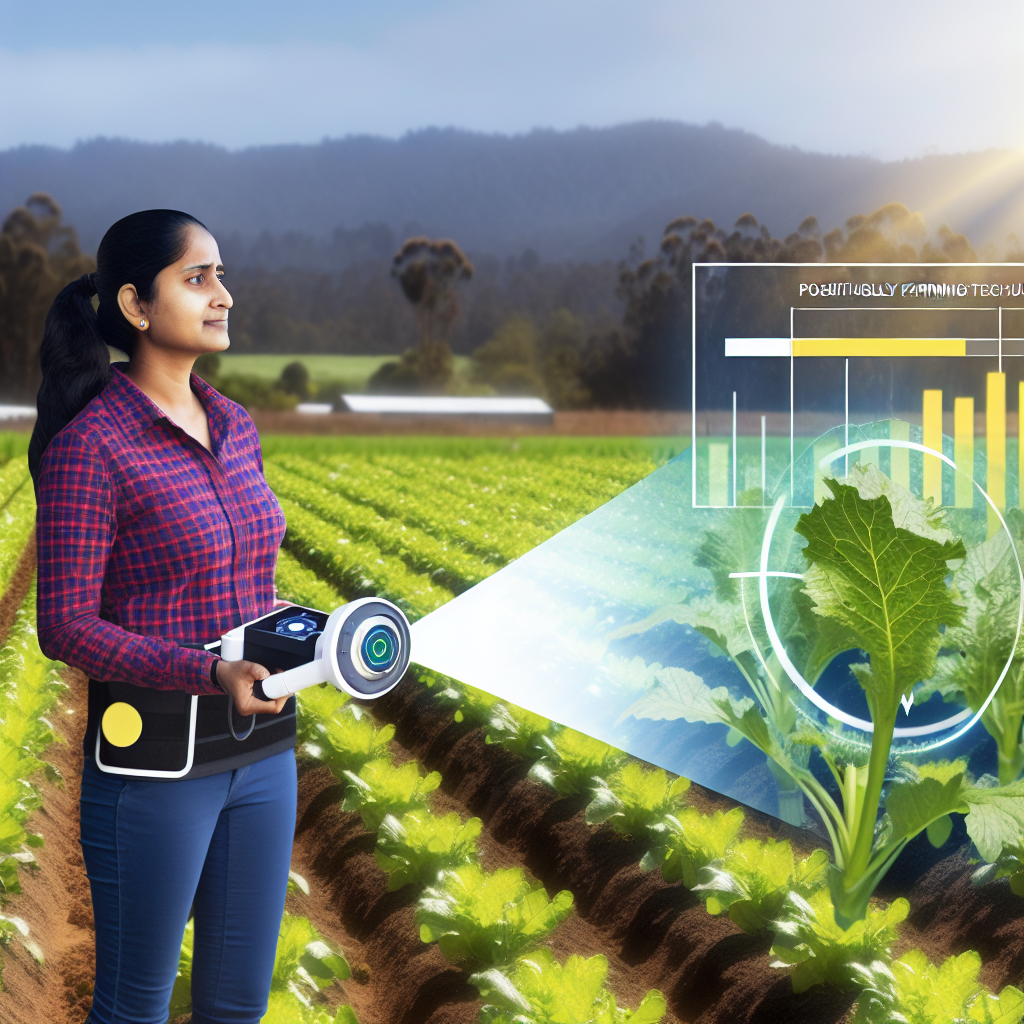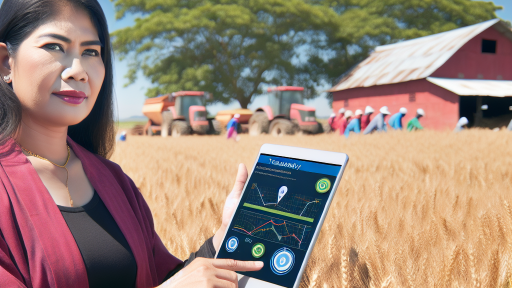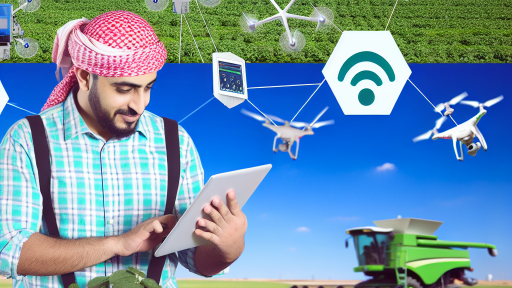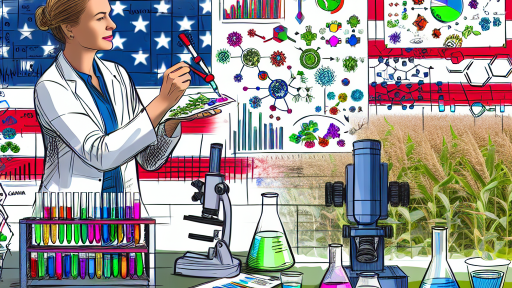Introduction to Sensor Technologies in Agriculture
Sensor technologies play a vital role in modern agriculture.
Farmers utilize these tools to enhance productivity and sustainability.
Moreover, sensors provide real-time data for informed decision-making.
As a result, agricultural practices become more efficient and precise.
Various types of sensors monitor essential agricultural factors.
Soil moisture sensors measure moisture levels to optimize irrigation schedules.
Temperature sensors track climate conditions impacting crop growth.
Additionally, nutrient sensors assess soil health for better fertilization.
These technologies contribute to resource conservation and reduced waste.
Furthermore, they aid in pest control by detecting pest populations early.
Ultimately, sensor technologies support sustainable farming practices.
They help farmers adapt to changing environmental conditions.
Through these innovations, the agriculture sector enhances food security.
Investing in sensor technologies promotes long-term viability for farming.
Overall, the integration of sensors transforms agricultural outcomes.
Transform Your Agribusiness
Unlock your farm's potential with expert advice tailored to your needs. Get actionable steps that drive real results.
Get StartedImportance of Sustainable Agriculture Techniques
Supporting Environmental Health
Sustainable agriculture promotes the health of ecosystems.
It fosters biodiversity by encouraging a variety of plants and animals.
Additionally, it reduces pollution and conserves water resources.
Enhancing Soil Quality
This approach significantly improves soil health.
Practices like crop rotation and cover cropping enrich the soil.
Healthy soil leads to better farm productivity and resilience.
Reducing Carbon Footprint
Sustainable techniques help lower greenhouse gas emissions.
They utilize renewable energy sources and minimize fossil fuel use.
This reduction supports global efforts to combat climate change.
Economic Viability
Investing in sustainable agriculture can be financially beneficial.
Farmers can save costs on inputs through efficient practices.
Moreover, consumers increasingly prefer sustainably sourced products.
Food Security
These techniques contribute to more stable food supplies.
They promote resilience against pests and climate variations.
As a result, sustainable agriculture enhances long-term food security.
Overview of Key Sensor Types Used in Farming
Soil Moisture Sensors
Soil moisture sensors measure the water content in the soil.
They help farmers optimize irrigation schedules effectively.
Moreover, these sensors reduce water waste significantly.
Some popular types include capacitive and resistive sensors.
Weather Stations
Weather stations collect data on temperature, humidity, and precipitation.
This data assists farmers in making informed decisions.
Furthermore, accurate weather predictions enhance crop management.
Automated systems provide real-time updates, improving responsiveness.
Crop Health Sensors
Crop health sensors monitor the condition of plants.
Showcase Your Farming Business
Publish your professional farming services profile on our blog for a one-time fee of $200 and reach a dedicated audience of farmers and agribusiness owners.
Publish Your ProfileThey detect stress, diseases, and nutrient deficiencies quickly.
Farmers can apply treatments more effectively using this data.
Common types include multispectral and thermal sensors.
Pest and Disease Detection Systems
Pest and disease detection systems utilize imaging technology.
These systems identify potential threats to crops early.
Once detected, farmers can take proactive measures promptly.
Drone technology enhances detection capabilities over large areas.
Livestock Monitoring Sensors
Livestock monitoring sensors track the health and activity levels of animals.
Wearable devices provide valuable data for better animal management.
Farmers can monitor feeding patterns and detect health issues.
Additionally, this technology reduces labor costs on farms.
Yield Monitoring Systems
Yield monitoring systems gauge the amount of crop harvested.
This technology helps farmers assess productivity accurately.
Data analytics facilitate better planning for future planting.
Real-time feedback allows immediate modifications to operations.
See Related Content: Comprehensive Agri-Fintech Overview Of Digital Payment Solutions For Farmers
Soil Moisture Sensors: Enhancing Water Conservation
Importance of Soil Moisture Sensors
Ssoil moisture sensors play a vital role in modern agriculture.
They monitor the water content in the soil.
This information helps farmers make informed irrigation decisions.
Consequently, it leads to better water conservation practices.
How Soil Moisture Sensors Work
These devices use various technologies to measure moisture levels.
Capacitive sensors detect soil moisture by measuring capacitance changes.
Resistive sensors measure the electrical resistance of the soil.
Both technologies provide real-time data to farmers.
Benefits of Using Soil Moisture Sensors
Implementing soil moisture sensors offers numerous advantages.
- They reduce water waste during irrigation.
- Farmers can optimize their irrigation schedules.
- They enhance crop yields by providing adequate moisture.
- These sensors help prevent overwatering and under-watering.
Case Studies in Effective Use
Many farmers have successfully adopted soil moisture sensors.
For instance, Sarah Thompson, an organic farmer in Iowa, saw significant results.
She decreased her water usage by 30% after installing these sensors.
Similarly, GreenEarth Farms in California improved their yields by 25%.
These examples illustrate the effectiveness of soil moisture sensors.
Gain More Insights: Revolutionizing Farming With Innovative Crop Disease Detection Technologies
Climate Monitoring Sensors: Understanding Microclimates
The Importance of Microclimates
Microclimates play a crucial role in agriculture.
They refer to small areas with distinct climate conditions.
Farmers can utilize microclimates to optimize crop growth.
By understanding small variations in temperature and humidity, they can improve yields.
Types of Climate Monitoring Sensors
Various types of sensors monitor microclimate conditions.
Temperature sensors provide real-time data on local weather.
Humidity sensors help track moisture levels in the air.
Soil moisture sensors offer deeper insights into ground conditions.
This comprehensive data aids in decision-making for farmers.
Showcase Your Farming Business
Publish your professional farming services profile on our blog for a one-time fee of $200 and reach a dedicated audience of farmers and agribusiness owners.
Publish Your ProfileBenefits of Using Climate Sensors
Climate sensors enhance resource management on farms.
They help optimize irrigation schedules based on accurate data.
Furthermore, these sensors enable timely interventions.
Farmers can adjust practices based on specific microclimate insights.
This leads to reduced water wastage and improved crop health.
Case Studies of Successful Implementation
Many farms have adopted climate monitoring sensors.
For instance, GreenField Farms increased their yield by 15% last year.
They utilized temperature and humidity sensors effectively.
Similarly, EcoGrow Enterprises reported reduced irrigation costs by 20%.
These examples illustrate the tangible benefits of using technology.
Future Trends in Climate Monitoring
The future of climate monitoring in agriculture looks promising.
Advancements in sensor technology will continue to emerge.
Cloud-based data analytics will enhance decision-making processes.
Farmers will increasingly rely on integrated systems for their operations.
Ultimately, these trends will lead to more sustainable practices across the industry.
Explore Further: Biomass Digesters for Renewable Farm Energy Production
Crop Health Monitoring Using Spectral Sensors
Introduction to Spectral Sensors
Spectral sensors play a crucial role in modern agriculture.
They analyze light reflected from crops to gather information.
This technology helps farmers understand crop health effectively.
How Spectral Sensors Work
Spectral sensors capture images in various wavelengths.
These images reveal insights about plant health and soil conditions.
Farmers use this data for real-time monitoring and decision-making.
Benefits of Using Spectral Sensors
Utilizing spectral sensors improves crop management significantly.
First, they help identify nutrient deficiencies early.
This early detection allows timely adjustments in fertilizer use.
Moreover, they assist in determining irrigation needs effectively.
Applications in Crop Health Monitoring
Several applications exist for spectral sensors in agriculture.
- Precision agriculture enhances target-specific interventions.
- Disease detection becomes more efficient through spectral analysis.
- Pest management strategies can be optimized with real-time data.
Case Studies of Successful Implementations
Numerous farmers have successfully implemented spectral sensors.
For instance, Greenfield Farms improved yields by 20% last season.
The technology allowed them to optimize resource usage effectively.
Additionally, Sunny Acres reduced pesticide use by 30% through precise monitoring.
Challenges and Future Prospects
Despite its advantages, using spectral sensors presents challenges.
Cost and training can hinder widespread adoption among farmers.
However, advancements in technology may lower these barriers.
Future innovations will likely enhance sensor capabilities and accessibility.
Delve into the Subject: Improving Soil Health With Agricultural Biotechnology

Pest and Disease Detection with IoT-enabled Sensors
Introduction to IoT in Agriculture
The integration of IoT technology in agriculture has transformed pest and disease management.
IoT-enabled sensors collect real-time data from the fields.
This data aids farmers in detecting pest infestations early.
Additionally, it contributes to monitoring plant health continuously.
Showcase Your Farming Business
Publish your professional farming services profile on our blog for a one-time fee of $200 and reach a dedicated audience of farmers and agribusiness owners.
Publish Your ProfileHow IoT Sensors Work
These sensors use a variety of technologies to gather information.
For instance, thermal imaging detects temperature changes in plants.
Such changes often indicate stress due to pests or diseases.
Moreover, humidity sensors monitor moisture levels that affect plant health.
Benefits of IoT Sensors for Detection
Implementing IoT sensors offers numerous advantages for farmers.
- Early detection of pests reduces crop damage significantly.
- Farmers can make informed decisions based on data analysis.
- Resource management improves with targeted pest control measures.
- Ultimately, it enhances sustainability in agricultural practices.
Case Studies and Real-World Applications
Many agricultural companies are utilizing IoT sensors effectively.
For instance, AgriTech Solutions has developed sensors specifically for pest detection.
Their technology has proven successful in fields of tomato and potato crops.
Similarly, FarmGuard implemented IoT devices to monitor vineyard health.
They reported a 30% reduction in pesticide use since the implementation.
Future Trends in IoT Pest Management
The future of pest and disease management looks promising with IoT advancements.
More sophisticated sensors will emerge, providing even greater insights.
AI algorithms will analyze data, predicting pest outbreaks accurately.
This predictive capability will significantly enhance farming efficiency.
Consequently, sustainable practices in agriculture will gain momentum.
Data Integration and Analysis for Precision Agriculture
Importance of Data in Agriculture
Data plays a crucial role in modern agriculture.
It helps farmers make informed decisions.
With accurate data, farmers can optimize their yields.
Additionally, data enhances resource management.
It also supports sustainability in farming practices.
Types of Data Collected
Farmers collect various types of data.
Soil moisture levels are essential for irrigation management.
Weather patterns help predict crop yields.
Crop health data allows for early pest and disease detection.
Market price trends inform planting decisions.
Tools for Data Collection
Numerous tools help in data collection efforts.
IoT sensors provide real-time information on field conditions.
Drones capture aerial imagery for crop monitoring.
Satellite imagery offers broader insights into land use.
Mobile applications facilitate easy data entry in the field.
Integrating Data Sources
Integrating different data sources maximizes its usefulness.
Farmers can combine weather data with soil analytics.
This combination leads to tailored irrigation strategies.
Using APIs, various systems can communicate effectively.
Integrating historical and real-time data creates powerful insights.
Analyzing Data for Actionable Insights
Data analysis transforms raw data into actionable insights.
Farmers utilize predictive analytics to anticipate future challenges.
Machine learning algorithms can identify patterns in crop performance.
By analyzing data trends, farmers can adapt their practices.
Furthermore, data visualization tools simplify complex information.
Showcase Your Farming Business
Publish your professional farming services profile on our blog for a one-time fee of $200 and reach a dedicated audience of farmers and agribusiness owners.
Publish Your ProfileBenefits of Data Integration and Analysis
Effective data integration and analysis offers numerous benefits.
It increases operational efficiency and reduces waste.
Farmers can achieve higher yields with less environmental impact.
Moreover, these practices enhance resilience to climate change.
Finally, informed decisions lead to improved profitability.
Future Trends in Sensor Technologies for Sustainable Farming
Advancements in Precision Agriculture
Precision agriculture continues to evolve with new sensor technologies.
These advancements enable farmers to monitor crops more effectively.
For instance, soil moisture sensors provide real-time data to optimize irrigation.
Additionally, satellite imagery helps assess crop health from above.
Farmers can now make data-driven decisions based on accurate information.
Integration with Internet of Things (IoT)
The integration of IoT with agricultural sensors is transforming farming.
Sensors connected to the internet allow for remote monitoring.
This leads to timely actions for pest control and crop management.
Moreover, data collected can enhance predictive analytics for yield forecasting.
Farmers gain insights to improve productivity and resource efficiency.
Environmental Monitoring and Sustainability
Environmental sensors play a crucial role in sustainable farming.
They monitor factors such as air quality, temperature, and humidity.
This information helps farmers mitigate adverse environmental effects.
Furthermore, it supports compliance with agricultural regulations.
As a result, farmers can operate sustainably and improve their ecological footprint.
Emerging Sensor Technologies
New sensor technologies are entering the agricultural landscape.
For example, drone-based sensors provide detailed crop imaging.
These drones capture high-resolution images for better analysis.
Likewise, wearable sensors monitor livestock health effectively.
These technologies will reduce labor costs and increase operational efficiency.
Big Data and Analytics
Big data analytics enhances the effectiveness of sensor technologies.
Farmers can analyze vast amounts of data collected from various sensors.
This analysis reveals patterns that inform management practices.
Additionally, it supports decision-making related to crop rotation and harvesting.
As a result, farmers become more efficient and reduce waste.
Future of Collaborative Farming
Collaborative farming will see increased use of sensor technologies.
Farmers can share data on weather patterns and soil conditions.
This collaboration fosters a community approach to sustainable practices.
Furthermore, it encourages knowledge sharing and resource pooling.
The future of agriculture lies in connectivity and shared insights.
Additional Resources
Research priorities to leverage smart digital technologies for …
UCF Researchers Lead Project to Develop AI-driven Technologies …




